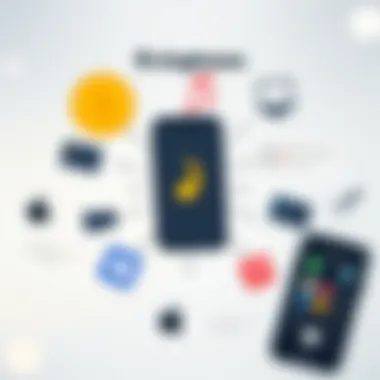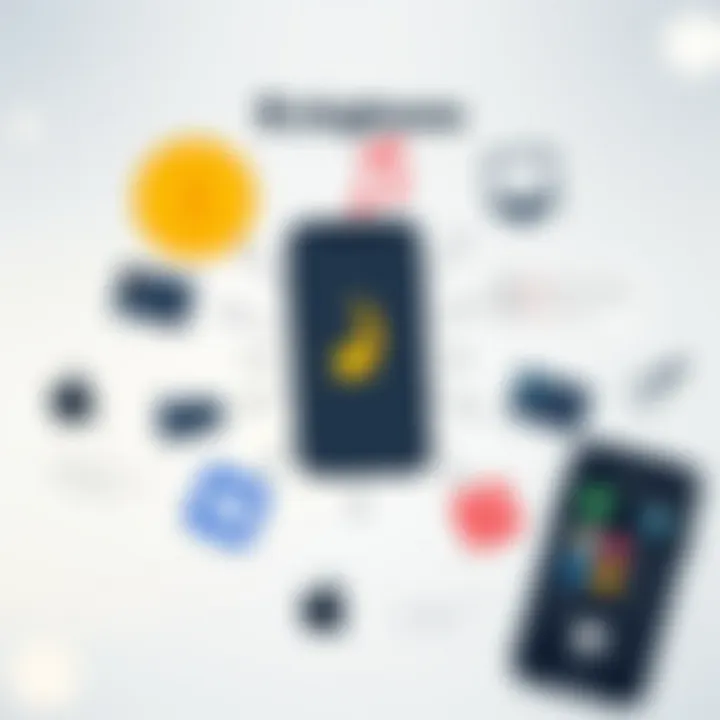The Evolution and Impact of iPhone Ringing Songs


Intro
In today's fast-paced digital world, the sound of an incoming call can often be more than just a signal of communication. The melody that accompanies a call, especially on an iPhone, has evolved into a reflection of personal identity and social status. Over the years, the way we perceive and select our iPhone ringing songs has shifted dramatically, transitioning from basic tones to intricate soundscapes that express individual tastes.
The significance of these tones extends beyond mere aesthetics. Ringtones are often considered an extension of one’s personality. For instance, someone might choose a classic rock anthem to project confidence and nostalgia, while another might prefer a calming piano piece for a more serene vibe. This choice, in many ways, often reveals subtle nuances about the individual’s character and lifestyle.
This article aims to peel back the layers on this fascinating topic, taking a close look at the various facets of iPhone ringtones. We'll explore how these auditory cues have developed over time, their cultural implications, and the artistry involved in crafting these unique sounds. Furthermore, we'll delve into the practicalities of customizing these tones across different iPhone models. Understanding these elements not only enhances the user experience but also provides insight into how such seemingly simple features can play a vital role in personal communication.
The Evolution of Mobile Ringtones
The journey of mobile ringtones is not just a mere evolution of sound; it’s a reflection of human communication and technological advancement. As mobile phones transitioned from being a luxury to a ubiquitous accessory, so too did the role of ringtones evolve. They became not just a means of alerting users to calls but also a way for individuals to express their personality and preferences. In this article, we will explore the intricacies of these auditory signals, particularly focusing on their evolution, cultural significance, and the creativity behind their creation.
Historical Context of Ringtones
In the earliest days of mobile phones, ringtones were quite basic. Initially, they were simple beeps and tones, akin to the electronic sounds of early digital devices. These early ringtones served a practical purpose: alerting users when a call was coming in. As technology advanced, so too did the sound options available for consumers. The introduction of polyphonic ringtones marked a pivotal moment, allowing for richer sounds and melodies. Remember the first time a Nokia phone rang with a catchy ringtone like "Nokia Tune"? It was a revelation! This historical context is crucial; it highlights how ringtones moved from utilitarian sounds to vital components of personal expression in our daily lives.
The rise of SMS and the incorporation of melody into the mobile experience caused users to view ringtones in a new light. Suddenly, they became more than just a call notification—they were an extension of one's personality. In this period, we saw the first hints of branding becoming intertwined with mobile sounds, as different manufacturers began to offer signature tones to distinguish their devices. As a result, ringtones started to represent not only technical capability but also cultural identity.
Transition to Digital Formats
The transition from analog to digital formats changed the landscape of mobile ringtones dramatically. As devices became digital, the ability to upload and create custom ringtones took off, offering greater flexibility and personalization options. This opened up a whole new world—users were no longer limited to preset ringtones. The advent of software tools allowed anyone with a computer to manipulate audio files and create their own unique sounds, making the ringtone landscape ripe for creativity.
- Custom Options: People could use snippets of their favorite songs or even create entirely new tracks, transforming their phones into a personal soundtrack.
- Availability of Formats: The shift to digital format also included the introduction of various file types like MP3, AAC, and M4R, making it easier to store and share ringtones across devices.
- Impact on Social Interaction: The ability to select or create personalized ringtones added a social aspect to communication. A memorable song could spark conversations or evoke memories, further deepening its role in our lives.
"Ringtones became a form of subtle communication—an audio signature that speaks volumes about who we are and what we cherish."
In sum, the evolution of mobile ringtones illustrates a fascinating blend of technology, art, and personal identity. By understanding the historical context and the technological shifts, we can better appreciate the cultural significance of ringtones today.
iPhone’s Unique Approach to Ringtones
The ways in which iPhones handle ringtones offer a glimpse into Apple's philosophy of customization and user experience. This unique approach is not merely a matter of aesthetics; it also serves to enhance the personal connection users have with their devices. Ringtones on the iPhone reflect individual preferences, making phone calls feel less like a disruption and more like a pleasant notification of an incoming connection. The richness of this strategy lies in the blend of simplicity and sophistication that characterizes Apple's ecosystem.
Key Elements of iPhone's Ringtone Strategy
- Hierarchy of Sounds: iPhones come with a well-curated library of default ringtones. These sounds, such as "Tri-Tone" or "Reflection," are designed to evoke specific feelings or associations, enhancing the auditory experience.
- Customization Potential: Users can create their own ringtones from music in their library or via audio editing apps. This allows a personal touch that lets individuals express themselves creatively.
- User-Friendly Interfaces: Navigating the ringtone settings is straightforward, thanks to iOS's intuitive interface. This ease of use encourages users to take advantage of the available options, ensuring they find or create a tone that resonates with them.
- Incorporation of New Trends: With every iOS update, Apple tends to introduce contemporary sounds that reflect current music trends, ensuring that the ringtone catalog remains fresh and relevant.
Ultimately, Apple's unique approach to ringtones encapsulates a deeper philosophy about user experience. The ringtones are not just an alert; they are an indelible part of personal identity in a digital landscape.
Default Ringtones: An Overview
The default ringtones on iPhones stand as a hallmark of the entire iOS experience. Apple, known for its attention to detail, offers a selection designed to please a wide variety of tastes. The classic sounds, like "Opening" and "Chimes," have become iconic over time, each evoking nostalgia and familiarity among users.
"Ringtones on iPhone are not just sounds; they are auditory symbols for connections and memories."
Each ringtone carries the weight of both aesthetics and usability. For instance, the “Reflection” ringtone has a soft, melodic quality, perfect for more formal settings, while “Horn” might be preferable for someone who enjoys a bit more flair. The carefully chosen tones are part of Apple's strategy to contribute to an emotionally resonating user experience.


User-Created Ringtones: Methods and Tools
While the default options are compelling, many users seek to forge their own sonic identity. User-created ringtones offer a chance to personalize one's phone beyond the standard offerings. Those looking to craft their own ringtones can utilize various methods and tools that are readily available on iPhones.
- GarageBand: This app allows you to create custom ringtones by using loops or recording your own sounds. It’s versatile and provides numerous tools to shape your audio.
- iTunes: By trimming songs to a specific length and converting them to the M4R format, users can manually create and sync ringtones through iTunes. This method might require a bit of patience, especially for those unfamiliar with audio editing, but the outcome can be uniquely satisfying.
- Ringtone Maker Apps: Numerous third-party apps found on the App Store simplify the process, letting you choose snippets from your favorite tracks and easily set them as ringtones.
In summary, the ability to create ringtones allows users to further refine their interaction with technology in a way that speaks to them personally. Whether it’s through music, sound effects, or recordings, iPhones afford their users a canvas to work from, fostering a distinctive auditory landscape.
Cultural Significance of Ringtones
The cultural significance of ringtones goes beyond mere functionality; they encapsulate personal identity and social trends. With each ring, the selected tone sends a message not only to the caller but also to bystanders, reflecting one's personality, preferences, and even social associations. For many, these audio snippets act as curated soundtracks of their lives, offering a clue into their passions and affiliations. Moreover, understanding ringtones reveals much about society’s evolving relationship with technology and communication. This connection establishes a framework for exploring how these auditory markers have found a place in modern life.
Ringtones as Personal Identity Markers
Ringtones often serve as a unique extension of one’s identity. When someone chooses a ringtone, it often reflects their personal taste in music or their cultural background. Whether it’s the latest hit from a popular artist or a classic melody from childhood, the chosen sound can speak volumes about the individual. More often than not, it’s not just about the sound itself but what it represents. For instance, a person setting a specific song from a renowned film may be paying homage to their favorite memories tied to that film or conveying a message to their social circle.
Additionally, ringtones can function as status symbols. Carrying the latest pop song or a unique, custom-made tone created via apps shows a penchant for staying current with trends. In select social circles, having a ringtone that is exceptionally rare or quirky can lead to a positive reputation, portraying that the owner possesses unique tastes or interests.
- Most personal ringtones evoke nostalgic emotions—ties to relationships or significant events.
- Many users rotate their ringtones based on life changes or milestones, creating a living diary through sound.
The Role of Popular Music in Ringtone Selection
Popular music has long dictated the landscape of ringtone choices. Artists often release singles that quickly become chart-toppers, and these tracks find their way onto mobile devices as ringtones almost instantaneously. This linkage between popular music and ringtones reflects larger cultural trends, showcasing how music serves as a universal language.
In older days, some figures like Britney Spears or 50 Cent led the charge, with their catchy beats becoming a staple in ringtone collections. The catchiness of a song is often a deciding factor in its ringtone selection; after all, a memorable hook or chorus is likely to stick in other people's minds, making it a common earworm.
Yet, trends change rapidly. Sub-genres of music are now also making their mark in the ringtone domain. Genres like lo-fi beats and indie tracks are taking the stage, showing that ringtones are not merely sticks to catch attention but a platform for diverse musical expressions.
Regional Variations in Ringtone Preferences
When delving into ringtone popularity, it’s clear regional differences emerge. For example, in the United States, pop and hip-hop trends dominate ringtone selections, while in regions like Japan, anime themes or J-pop melodies are more prevalent. This contrast highlights how cultural backgrounds influence musical preferences.
In certain countries, traditional ringtones can interface with local music styles. For instance, in Italy, classical music snippets often serve as ringtones, embodying the rich cultural heritage. In contrast, street artists in South African townships may find local hip hop dominating their ringtone choices, showcasing authenticity and pride.
Different audiences also gravitate towards distinct moods in ringtones. Some may appreciate upbeat tracks, while others might find a calming instrumental more appealing. It’s fascinating how local cultures unfold through these selections, embedding identity deeper into the sounds people choose.
This diversity offers rich insights representing a cross-section of global cultures and their auditory markers, reminding us of our vast shared experience even in simple things like ringtones.
In summary, understanding the cultural importance of ringtones provides a lens into identity, music influence, and regional differences. Each ring is a story, a slice of the everyday human experience, communicated through sound.
Composition and Artistry Behind Ringtones
The creation of ringtones involves more than just choosing a catchy melody; it reflects a unique intersection of art and technology. Effective ringtones resonate not just in a musical sense but hold a significant role in defining personal identity and communication styles. Understanding the art behind these short musical snippets can enhance both the auditory experience and the emotional connection users feel towards their devices. This depth is especially relevant to iPhone users who appreciate both aesthetics and functionality in their gadgets.
Musical Elements of Effective Ringtones
When we dissect what makes a ringtone stand out, three primary elements come to the forefront: melody, rhythm, and harmony.


- Melody: The melody is often the most identifiable aspect of a ringtone. It should be memorable enough for the listener to recognize it immediately, even among a crowd of other sounds. Think of the iconic iPhone default ring; it embodies simplicity yet leaves a lasting impression.
- Rhythm: The rhythmic pattern plays a critical role in grabing attention. A driving rhythm can create urgency while a more laid-back tone can convey calm. This is why some users prefer upbeat tunes, as they tend to inject a burst of energy into mood.
- Harmony: Harmony complements the melody and can be used to evoke certain emotions. A major key might suggest happiness and cheer, while a minor key can capture melancholy. It's the emotional undertone that often dictates whether a ringtone feels right for the individual.
Many creators often look at popular songs and dissect their musical elements to understand why they evoke certain feelings. This analysis can aid them in composing original ringtones that resonate on a personal level. For instance, adding a bass line might set a more dramatic tone compared to a glimmering synth line that elicits excitement.
Balancing Catchiness and Length
Crafting the perfect ringtone is like striking gold; it requires a fine balance between catchy hooks and suitable length.
A catchy ringtone ensures that it grabs attention quickly. Most users will not give their phones a second chance to play a long melody; they need that instant recognition. So, getting the hook right is paramount. Ringtones that expand into long intros are often skipped over, which is why the best ones usually get to the point within just a few seconds.
However, there’s the question of length. The ideal ringtone shouldn’t exceed around 30 seconds. This is both a matter of practicality and user experience. Anything longer feels excessive, and there’s often a need for brevity in our fast-paced world. Users expect a quick, memorable alert without unnecessary filler, instead opting for substantial bits of music that convey a lot in just a short duration.
In many cases, ringtones are crafted with repeated phrases that reinforce recognition without wearing out their welcome. Each iteration should feel fresh and exciting, appealing to the user’s desire to stand apart while still capturing the essence of the melody.
Ringtones are not just sounds; they are an extension of personality and taste, creatively merging technology and artistry.
In summary, composing effective ringtones requires a keen understanding of musical components along with the art of brevity. The ringtones that endure long past their release are often those that continue to echo personal significance and resonate positively with their users. The craftsmanship involved speaks to a world where sound choices impact identity and interaction, specifically within the dynamic environment of iPhone users.
Technical Aspects of Ringtones on iPhones
Understanding the technical aspects of ringtones on iPhones is crucial for anyone looking to personalize their mobile experience. As smartphones have become integral to our daily lives, the way we interact with them through sound has evolved significantly. Ringtones are no longer just auditory alerts; they're a reflection of our individuality and preferences. By grasping the technical parameters that govern ringtones, users can optimize their selections for clarity, compatibility, and uniqueness.
File Formats Compatible with iPhones
iPhones support several audio file formats, and knowing these formats can save users from a world of frustration. While many are tempted to convert their favorite songs into ringtones, not all formats will play nice with iOS. The primary formats you need to be aware of are:
- AAC (.m4a): This is the standard format for iTunes music and is widely compatible with iPhones.
- MP3 (.mp3): A popular choice for ringtones, but users should be cautious of potential quality loss with compression.
- WAV (.wav): Offers uncompressed audio, which is great for sound quality but can take up significant storage space.
- AIFF (.aiff): Similar to WAV in terms of quality and file size, this format also works seamlessly with Apple devices.
When preparing a ringtone, the .m4r extension is specifically designed for iPhone ringtones. Therefore, converting other formats to .m4r will ensure your selected audio plays without issues.
How to Transfer Ringtones to an iPhone
Transferring ringtones to an iPhone might seem daunting at first, but it’s a straightforward process once you get the hang of it. Here are a few methods to accomplish this task.
- Using iTunes:
- Using Finder on macOS Catalina and Later:
- Using Third-Party Apps:
- Open iTunes and connect your iPhone to your computer.
- Drag and drop your .m4r ringtone file into the "Tones" section of iTunes.
- Sync your device by clicking the Sync button.
- Connect your iPhone and open Finder.
- Select your device from the sidebar.
- Drag your .m4r file into the "Tones" section.
- Click Sync to transfer ringtones.
- Various applications can simplify the process, like AnyTrans or Waltr. Just follow their prompts to add ringtones to your device.
The ability to customize ringtones transforms a simple alert sound into an expression of one’s personality. It's a subtle art form that balances technical understanding and creative expression.
By familiarizing yourself with the file formats and methods to transfer ringtones, you ensure that the audio signals on your iPhone not only catch your attention but also resonate with your identity.


Managing Ringtones on iPhones
Managing ringtones on iPhones holds particular significance as it allows users to personalize their device, enhancing their communication experience. This aspect is not merely a matter of style; it reflects one’s individuality and can even influence the way one interacts with the world. A well-chosen ringtone can evoke memories, sentiment, or simply serve as an effective alert for incoming calls and messages. Furthermore, it allows users to maintain a sense of order amid the cacophony of daily notifications.
The ability to manage ringtones effectively means that users can customize notifications according to time, place, or even the person reaching out. This underscores not just convenience but also a deeper layer in the relationship users have with their devices. Understanding how to navigate these options provides them with tools to assert control over their technology.
Setting Up Ringtones in iOS
Setting up ringtones in iOS is a straightforward process that empowers users to add a touch of personalization to their devices. On a fundamental level, this entails choosing a sound that resonates with one’s personality or serves a functional purpose. Here’s a step-by-step guide on how users can set ringtones:
- Open Settings: Start by launching the Settings app on the iPhone. This is the hub from which all device configurations can be managed.
- Navigate to Sounds & Haptics: Scroll down and select Sounds & Haptics. This section includes options for various alerts and notifications.
- Select Ringtone: Tap on Ringtone, which will prompt a list of available tones.
- Choose Your Ringtone: Users can now preview each ringtone. Tap on it to select the preferred choice. Once selected, it is set as the default ringtone for incoming calls. For additional variety, users can also choose specific ringtones for individual contacts. Going to Contacts, selecting a contact, and then able to assign unique ringtones from there adds another layer of customizability.
Adjusting Volume and Vibration Settings
Adjusting volume and vibration settings is another crucial aspect of managing ringtones. The iPhone’s silent vibrate mode often plays a pivotal role in professional environments or in situations where sound is inappropriate. Users can dial in their settings to strike a balance between auditory alerts and silent notifications. Here’s how to execute these changes:
- Volume Settings:
- Vibration Patterns:
- In the Settings app, go to Sounds & Haptics.
- Here, users can swipe the Ringer and Alerts slider to control the overall volume of ringtones and alerts. This adjustment helps avoid those pesky moments when phones are too quiet to be heard or disruptively loud.
- Within the Sounds & Haptics section, users can also customize their vibration settings.
- Tap on Vibration to select from the predefined patterns or create a custom one. Custom vibrations offer a unique touch — for example, a different pattern signals a work-related call versus a personal one.
While it may seem minor, these settings contribute significantly to the user's overall handling of their iPhone. Proper adjustment greatly enhances how information is conveyed through the device, allowing users to remain connected while maintaining their preferred level of engagement.
"Managing ringtones and settings on your iPhone is not just about sound; it’s about clarity in one's communication and personal expression."
By comprehensively managing ringtones and notifications, users deepen their relationship with technology while crafting an experience that is uniquely their own.
Future Trends in Ringtone Development
Understanding the future landscape of ringtone development is crucial as it directly impacts how users engage with their devices. As technology evolves, so too does the way we approach customization of our auditory experiences. There is a notable shift towards integrating AI and machine learning into creating ringtones that reflect our moods, preferences, and even environments. Below, some key aspects of this exciting era in ring tones will unfold.
Emerging Technologies and Innovations
The innovative prospects for ringtone technology are as diverse as they are promising. One significant trend smart devices are embracing is context-aware ringtones. Unlike traditional sounds that are static and predefined, these new ringtones adapt based on your situation. For instance, during a meeting, your phone might automatically switch to a more discreet sound.
Moreover, with the advent of 3D audio technology, users can expect a more immersive experience. With this tech, ringtones could utilize spatial sound effects, making it seem as if the ringtone is coming from a particular direction, enhancing the auditory landscape of personal notifications.
- AI-Generated Ringtones: Services like OpenAI's Jukebox are pioneering avenues where users can create ringtones using AI. Individuals can input their favorite genres, and the AI will churn out a unique composition.
- Interactive Ringtones: Imagine a ringtone that changes based on the caller. For example, a family member's call might trigger a nostalgic tune, while work contacts could bring up a more professional sound. This dynamic adaptation can deepen the personal connection users have with their communication devices.
These advancements are not just clever tricks; they reflect deeper user engagement and satisfaction. Every notification becomes a tailored experience, setting the stage for a new era in user-device interaction.
Personalization in the Age of AI
Personalization is no longer a luxury; it’s expected. As society leans more into AI, ringtones are becoming highly customized, ensuring that every individual feels a sense of ownership over their devices. Here’s how that’s shaping up:
- Learning Algorithms: AI algorithms can track user interactions. For instance, if a user frequently selects upbeat pop music for their alerts, the system can suggest new tones within that genre, making the selection process more aligned with personal taste.
- Mood-Based Ringtones: Utilizing biometric data, phones might soon adjust ringtones based on the user's emotional state. If a person is feeling stressed, the phone could play calming tones, whereas during a cheerful moment, a more upbeat sound might emerge.
- User-Generated Content Platforms: As platforms like TikTok proliferate, users will constantly upload sounds. These platforms might evolve to offer easy conversion of popular snippets into ringtones, keeping them current and relevant.
The evolution of ringtones isn’t merely about aesthetics; it also involves emotional resonance with users. Ultimately, the marriage of technology with personal nuance is redefining what a standard ringtone can be.
"Ringtones will become an expression of individuality and emotional intelligence, aligning with the wearer’s psyche."
As we navigate this digital age, the implications are vast. Each sound that penetrates our daily lives carries the potential to shape how we communicate—our interactions made not just effective but also profoundly personal. The future of ringtone development is indeed a domain worth watching.

